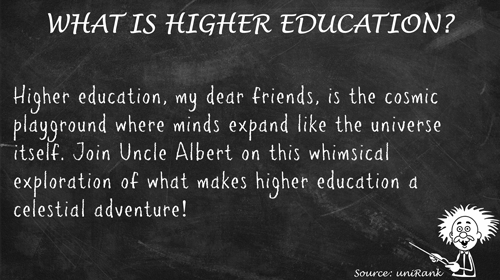
What is Higher Education?
Published: • Modified:
Introduction
Higher education, also called tertiary education, refers to learning beyond the secondary or high school level. It includes undergraduate and graduate studies offered by universities, colleges, vocational schools and professional institutes. In today’s global economy, higher education plays a vital role in preparing individuals for careers, fostering innovation and supporting societies and economies worldwide.
As more professions require advanced knowledge and specialized skills, higher education has become essential for personal success and national development. This article explains the meaning, history, benefits, challenges and future of higher education from an international perspective.
Definition of Higher Education
Higher education builds upon high school and provides advanced academic or professional training. It spans research universities, liberal arts colleges, community colleges, technical institutes and professional schools. Programs lead to recognized degrees, diplomas, or certificates, equipping students with expertise in specific fields and transferable skills such as critical thinking, communication, problem-solving and teamwork.
A Brief History of Higher Education
Ancient centers of learning such as Nalanda (India), Al-Qarawiyyin (Morocco) and the academies of classical Greece exemplify early advanced study. In medieval Europe, universities like Bologna, Oxford and Paris formalized degrees and faculties, shaping the modern model. Over time, this model spread globally and blended with local traditions. Access widened significantly from the late 19th to early 20th centuries as public funding and policy reforms democratized higher education, enabling millions of first-generation students to earn degrees. In the 20th and 21st centuries, international mobility, research collaboration and digital learning transformed scale and delivery worldwide.
Benefits of Higher Education
Individual benefits: Advanced knowledge, professional qualifications and life skills—leadership, adaptability, collaboration—support better employment opportunities, higher earnings potential and greater job security. Higher education also fosters independence, confidence and lifelong learning.
Social benefits: Universities drive research and innovation, address global challenges, enrich cultural life and encourage civic participation—strengthening social cohesion and public well-being.
Economic benefits: A skilled workforce boosts productivity, entrepreneurship and long-term prosperity. Universities stimulate regional development and create high-value jobs.
Types of Higher Education Institutions
- Universities: Comprehensive institutions offering undergraduate and graduate programs, often research-intensive.
- Colleges: Stand-alone teaching institutions or parts of a university; community or junior colleges often provide two-year pathways.
- Vocational and technical schools: Career-focused training in applied sciences, engineering, healthcare, trades, hospitality and more.
- Professional and specialized schools: Focused on medicine, law, business, arts, teacher education and other fields.
Types of Degrees and Credentials
- Associate degrees: Typically two-year programs leading to employment or transfer to a bachelor’s.
- Bachelor’s degrees: Three to four years of undergraduate study with broad and specialized coursework.
- Master’s degrees: One to two years of postgraduate specialization or professional advancement.
- Doctoral degrees: Highest academic qualifications (research doctorates and professional doctorates).
- Certificates and diplomas: Short, targeted programs building specific industry skills.
Global Differences in Higher Education
- Structure: Some systems separate research universities from applied institutions; others feature distinctive models such as the grandes écoles.
- Duration: Many European bachelor’s programs last three years; in the United States they typically last four. Professional pathways vary widely.
- Access: Admissions may rely on competitive exams, high-school performance, or open-access policies.
- Funding: Some nations offer low-cost or tuition-free study; others rely more on fees and student loans.
- Delivery: Online and blended learning are increasingly common and support flexible, lifelong learning.
Challenges of Higher Education
- Cost: Rising tuition and student debt constrain affordability.
- Access: Financial, geographic, informational, social and cultural barriers persist.
- Relevance: Programs must keep pace with technological change and evolving labor markets.
- Equity and inclusion: Expanding participation for underrepresented groups remains essential.
Higher Education as Lifelong Learning
Education increasingly continues beyond a single degree. Short courses, micro-credentials, professional certifications and flexible online or part-time options help individuals reskill and upskill throughout their lives—enhancing employability, adaptability and civic participation.
In Summary
Higher education is more than academic study—it is a driver of personal growth, social progress and economic development. From its ancient roots to today’s global systems, it expands opportunity and fuels innovation. While affordability, access and relevance remain challenges, higher education continues to empower individuals and strengthen communities around the world.
Frequently Asked Questions (FAQs)
What is the purpose of higher education?
To provide advanced knowledge, professional skills and personal development that prepare individuals for meaningful careers, informed citizenship and lifelong learning.
What are examples of higher education institutions?
Universities, liberal arts colleges, community or junior colleges, technical and vocational institutes and professional schools such as medical, law and business schools.
What are the main types of higher education degrees?
Associate, bachelor’s, master’s and doctoral degrees, plus shorter programs such as certificates, diplomas and micro-credentials.
How does higher education differ around the world?
Systems vary in structure, program length, admissions, funding and delivery. For example, bachelor’s programs are often three years in Europe and four in the United States and some countries separate research and applied institutions.
Is higher education the same as university education?
Not exactly. University education is one part of higher education, which also includes colleges, community colleges, vocational institutes and professional schools.
Can higher education be pursued online?
Yes. Many accredited institutions offer online and blended programs, providing flexible options for working adults and international students.
What skills do students gain from higher education?
Beyond subject expertise, graduates build critical thinking, research, communication, teamwork, digital literacy, leadership and problem-solving skills.
Is higher education worth the cost?
For many students, the long-term benefits—better employment prospects, higher earnings potential and personal growth—outweigh the costs. Value varies by country, institution, field of study and individual goals.
How do students pay for higher education?
Common options include scholarships, grants, student loans, employer sponsorship and personal or family savings. Availability depends on the country and institution.
What is the difference between undergraduate and postgraduate education?
Undergraduate study leads to associate or bachelor’s degrees. Postgraduate study follows a bachelor’s and includes master’s and doctoral programs for further specialization.
What is accreditation in higher education?
Accreditation is an external quality-assurance process confirming that an institution or program meets established standards. Employers and other universities typically prefer accredited qualifications.
Can adults return to higher education later in life?
Yes. Many institutions support mature learners with part-time, evening and online options, enabling career changes, advancement, or personal enrichment.
How do I choose the right higher education institution?
Consider accreditation, academic strengths, faculty, learning mode, tuition and aid, location, facilities, student support, internship opportunities and graduate outcomes.

